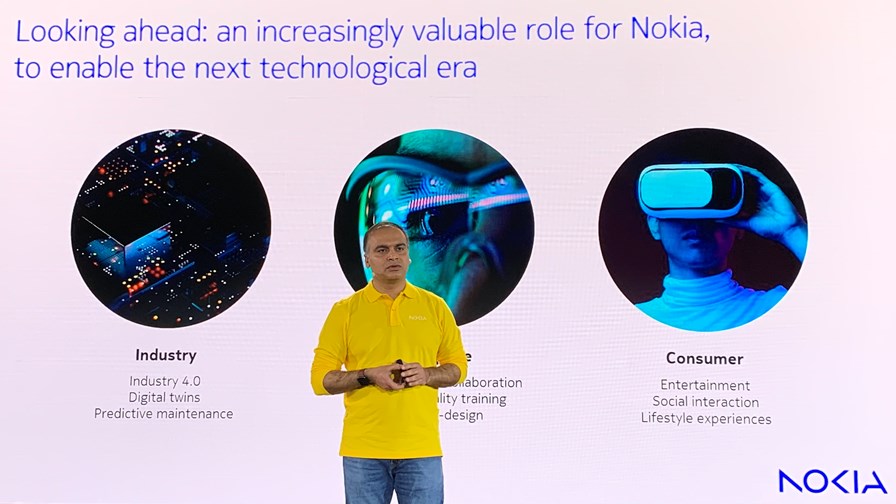
Nishant Batra, chief strategy and technology officer at Nokia, provides a business update at a pre-MWC event in Barcelona, 2023.
- Vendor giant sets its sights on an industrial metaverse-driven future
- It believes a new approach to network architecture will be needed in the next seven years
- Networks that can sense, think and act will be required
BARCELONA – #MWC23 – Nokia believes it is in a “unique position” to capture opportunities in the industrial metaverse by developing network systems that can sense, think and act, rather than just connect.
At a press and analyst briefing here on Sunday, ahead of MWC23, Nokia’s chief strategy and technology officer (CSTO), Nishant Batra (pictured above), shared the company’s vision for the coming seven years in the run up to 2030 and the era of the immersive metaverse.
“This is the new age of digitalisation – and in this age, there will be digitally augmented worlds, there will be solutions to different challenges and, equally importantly, there will be new business opportunities for players like ourselves,” stated Batra.
Having played a foundational role in building the connectivity infrastructure, Nokia, he believes, is now in a unique position to grow its presence in other areas, such as edge computing, and prove it is not “just an infrastructure player” but that it can also serve as “the platform for transformation” for several industries.
Batra pointed out that there are three different types of metaverse: The consumer domain, with offerings for social interactions, entertainment and gaming; the enterprise domain, which is set to bring immersive collaboration, remote working, extended reality (XR) training and digital co-design; and the industrial metaverse, where “physical industries get digitalised through immersion”.
And it is the industrial metaverse that Nokia, its CSTO claims, is “most excited about”, as data from research company ABI Research has suggested that this is growing “much faster” than the consumer domain.
According to Nokia’s own analysis, current enterprise data traffic is dominated by smartphone video streams and files, “but our estimate is that after 2027, the network traffic will be dominated by XR – and that’s the network we will need to build,” said Batra.
The network of the future
To support the changing needs of its consumer, especially in the industrial domain, Nokia envisions that networks of the future “don’t just connect”, noted Batra. “What I believe is that networks will be equally used for sensing and that will then create a need for thinking and acting. So our belief is that the networks of the future will sense, think and act.”
Additionally, the vendor needs to build networks not only for performance but to make them “equally consumable” and open for innovation, so that developers are able to tap into and build on their potential. “This allows every other industry to consume these networks to potentially transform themselves” and eventually harness the power of 6G, he argued.
“When we are building for this world of immersive metaverse, it’s far more complex than the world of connectivity we have today. Trust and identity will be very crucial – and not just for social and entertainment purposes,” but also for addressing three of the biggest requirements for enterprises – productivity, efficiency and safety.
Batra insisted that the time is now “for those businesses, enterprises and industries to start envisioning their metaverse-driven strategies,” and he added that Nokia wants to work with those customers in their journey towards digitalisation.
Other ingredients of the future network, according to Nokia’s CSTO, include a “real-time digital twin” that can help in settings such as a power plant, where no intervention will be required as potential issues will be resolved automatically. In another example provided by Batra, engineers working on gas turbines will not have to test physical parts to figure out power efficiencies, as they will be able to rely on a digital twin for such insights.
And this future will require much greater location accuracy, with networks able to identify the source of a connection to within 1 centimetre rather than a few metres. “That creates a lot of innovation, but also a lot of good business opportunities. This is where the industry truly uses the value of future networks”, he explained.
But, of course, none of this will be enabled by one company alone. Nokia will need partners. "It is going to be an extremely important characteristic of successful metaverse companies to be able to collaborate,” said Batra, adding that the company is already collaborating at the developer level and is inviting other partners to collaborate too.
Pekka Lundmark, president and CEO of Nokia, added that in order for industries to transform as quickly as possible, “the qualities of traditional networking need to integrate the flexibility and scalability of the cloud. When networks meet cloud, this will unleash the full promise of the industrial, enterprise and consumer metaverses,” he said.
Nokia’s network vision was announced alongside an enterprise-focused business strategy update and the unveiling of a logo refresh that aims to distance the company from its consumer handset past – see Nokia signals greater enterprise push with brand ‘refresh’.
- Yanitsa Boyadzhieva, Deputy Editor, TelecomTV
Email Newsletters
Sign up to receive TelecomTV's top news and videos, plus exclusive subscriber-only content direct to your inbox.




